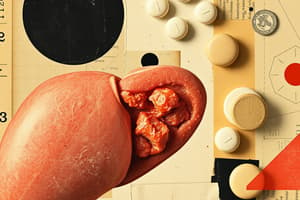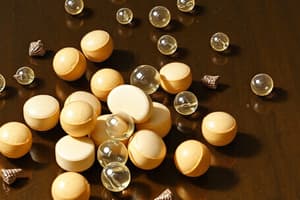Podcast
Questions and Answers
What is a common side effect associated with niacin?
What is a common side effect associated with niacin?
- Flushing and itching (correct)
- Vision changes
- Dry mouth
- Severe headaches
Patients with renal impairment require a dosage increase for antihyperlipidemic agents.
Patients with renal impairment require a dosage increase for antihyperlipidemic agents.
False (B)
What should patients do to prevent drug interactions?
What should patients do to prevent drug interactions?
Inform their physicians of all other medications they are taking.
Regular monitoring of _______ is necessary when patients are taking statins to assess liver function.
Regular monitoring of _______ is necessary when patients are taking statins to assess liver function.
Why is adherence to a medication schedule important?
Why is adherence to a medication schedule important?
Match the antihyperlipidemic agents with their potential issues:
Match the antihyperlipidemic agents with their potential issues:
Pregnancy and lactation should not be considered when prescribing antihyperlipidemic medications.
Pregnancy and lactation should not be considered when prescribing antihyperlipidemic medications.
What role do lifestyle modifications play in combination therapies?
What role do lifestyle modifications play in combination therapies?
What is the primary action of statins in the body?
What is the primary action of statins in the body?
Bile acid sequestrants promote the reabsorption of bile acids in the intestine.
Bile acid sequestrants promote the reabsorption of bile acids in the intestine.
What type of hyperlipidemia is characterized by elevated levels of both LDL cholesterol and triglycerides?
What type of hyperlipidemia is characterized by elevated levels of both LDL cholesterol and triglycerides?
________ target the PCSK9 protein to reduce the degradation of LDL receptors on the liver.
________ target the PCSK9 protein to reduce the degradation of LDL receptors on the liver.
Match each mechanism of action with the corresponding lipid-lowering agent:
Match each mechanism of action with the corresponding lipid-lowering agent:
Which of the following is NOT a common side effect of fibrates?
Which of the following is NOT a common side effect of fibrates?
Secondary hyperlipidemia can be caused by diabetes and hypothyroidism.
Secondary hyperlipidemia can be caused by diabetes and hypothyroidism.
Name the lipoprotein primarily involved in transporting triglycerides.
Name the lipoprotein primarily involved in transporting triglycerides.
Flashcards
Antihyperlipidemic agents
Antihyperlipidemic agents
A group of medications used to lower cholesterol levels in the blood.
Niacin side effects
Niacin side effects
Side effects associated with niacin therapy include flushing, itching, and potential gastrointestinal issues.
PCSK9 inhibitors
PCSK9 inhibitors
PCSK9 inhibitors are a newer class of drugs that lower cholesterol by blocking the action of PCSK9, a protein that increases cholesterol levels.
Lifestyle modifications for cholesterol management
Lifestyle modifications for cholesterol management
Signup and view all the flashcards
Liver function monitoring with statins
Liver function monitoring with statins
Signup and view all the flashcards
Combination therapy for cholesterol
Combination therapy for cholesterol
Signup and view all the flashcards
Drug interactions with antihyperlipidemics
Drug interactions with antihyperlipidemics
Signup and view all the flashcards
Precautions with antihyperlipidemics
Precautions with antihyperlipidemics
Signup and view all the flashcards
What are antihyperlipidemics?
What are antihyperlipidemics?
Signup and view all the flashcards
How do statins work?
How do statins work?
Signup and view all the flashcards
How do bile acid sequestrants work?
How do bile acid sequestrants work?
Signup and view all the flashcards
How do fibrates work?
How do fibrates work?
Signup and view all the flashcards
How does niacin work?
How does niacin work?
Signup and view all the flashcards
How do PCSK9 inhibitors work?
How do PCSK9 inhibitors work?
Signup and view all the flashcards
What is hypercholesterolemia?
What is hypercholesterolemia?
Signup and view all the flashcards
What is hypertriglyceridemia?
What is hypertriglyceridemia?
Signup and view all the flashcards
Study Notes
Mechanisms of Action
- Statins primarily inhibit HMG-CoA reductase, a key enzyme in cholesterol synthesis, leading to reduced cholesterol production in the liver.
- Bile acid sequestrants bind bile acids in the intestine, preventing their reabsorption and promoting their excretion. This forces the liver to use cholesterol to synthesize more bile acids, effectively lowering cholesterol levels.
- Fibrates primarily activate lipoprotein lipase, increasing the breakdown and clearance of triglycerides. They also affect the production of apolipoproteins, which are important components of lipoproteins involved in lipid transport. Different fibrates have varied effects on triglycerides and HDL-C depending on their specific chemical structure.
- Niacin (nicotinic acid) reduces the production of VLDL (very-low-density lipoproteins), which transport triglycerides, and increases the clearance of triglycerides from the blood. It also increases HDL-C, playing a broader role in lipid metabolism.
- PCSK9 inhibitors directly target PCSK9 protein, reducing the degradation of LDL receptors on the liver surface. This leads to increased LDL uptake by the liver, removing more LDL cholesterol from the circulation.
Types of Hyperlipidemia
- Hypercholesterolemia: Elevated levels of LDL cholesterol.
- Hypertriglyceridemia: Elevated levels of triglycerides.
- Mixed hyperlipidemia: Elevated levels of both LDL cholesterol and triglycerides.
- Dyslipidemia: An abnormal concentration of lipids in the blood, which includes hypercholesterolemia, hypertriglyceridemia, and low HDL cholesterol levels.
Indications for Use
- Primary hyperlipidemia: Elevated LDL cholesterol or triglycerides due to genetic predisposition or lifestyle factors.
- Secondary hyperlipidemia: Elevated lipid levels resulting from other medical conditions, such as diabetes, hypothyroidism, or kidney disease.
- Elevated cardiovascular risk: High cholesterol, regardless of genetic or secondary cause, can increase the risk of heart attack or stroke, and antihyperlipidemics are used to lower that risk.
Side Effects
- Statins: Myalgia (muscle pain), myopathy (muscle damage), elevated liver enzymes (hepatotoxicity).
- Bile acid sequestrants: Constipation, bloating, and abdominal pain. They can also interfere with the absorption of fat-soluble vitamins.
- Fibrates: Myalgia and muscle weakness, elevated liver enzymes. Potentially increase the risk of gallstones, especially with higher doses.
- Niacin: Flushing, itching, and gastrointestinal issues.
- PCSK9 inhibitors: Injection site reactions, and rare occurrence of allergic reactions. Immunological concerns related to injection frequency are also important to consider.
Patient Counseling
- Importance of lifestyle modifications: Dietary changes, increased physical activity, and weight loss often play a crucial role in combination therapies for optimum results.
- Adherence to medication schedule: Consistent dosing is key for efficacy and to avoid serious sequelae to therapy.
- Monitoring liver function: Regular blood tests are necessary to assess liver function when taking statins.
- Monitoring lipid profiles: Regular lipid panel tests are necessary to evaluate the effectiveness of therapy.
- Patient education on potential side effects, and encouraging them to report any concerns.
- Interaction with other medications: Patients should inform their physicians of all other medications they are taking to prevent drug interactions. It is critical to prevent drug interactions.
Contraindications and Precautions
- Liver disease: Patients with pre-existing liver problems might need to use antihyperlipidemic agents cautiously or not at all.
- Active or chronic muscle disease: Statins pose a greater risk for those with pre-existing muscle problems.
- Pregnancy and lactation: Usage in these situations should be in consultation with a physician to weigh risks and benefits carefully.
- Renal impairment: Dosage adjustments might be necessary for patients with kidney problems.
- Some fibrates can interact negatively with statins, so prescribing practices need to take this into account. Using fibrates in combination with statins can be complicated.
Combination Therapies
- Combining different antihyperlipidemic agents can create synergistic effects, lowering multiple lipid parameters more effectively.
- Determining the optimal combination requires careful consideration of individual patient factors and responses.
Other Considerations
- Recent studies have highlighted the importance of managing other risk factors for cardiovascular disease, including blood pressure, blood sugar control, and lifestyle adjustments, in addition to cholesterol management.
- The selection of a specific antihyperlipidemic agent is typically individualized, and often involves a stepwise approach, based on the individual patient's conditions, medical history, and response to treatment.
Studying That Suits You
Use AI to generate personalized quizzes and flashcards to suit your learning preferences.



